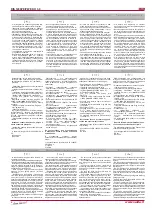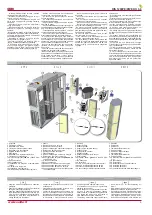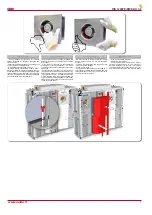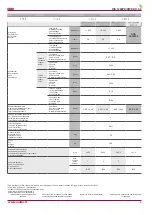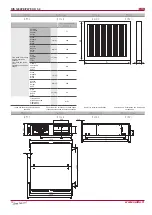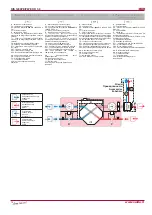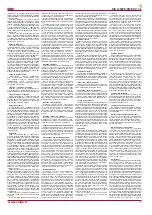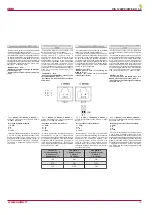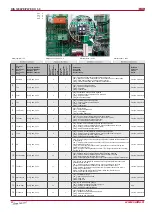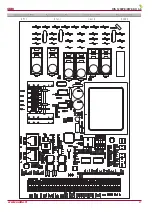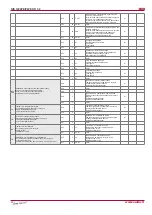
18
RIS 1200PE/PW EKO 3.0
www.salda.lt
a)
Vandeninio šildytuvo apsaugai yra sudaryti
keli apsaugos laiptai.
Pirmasis:
jei šaltuoju metų laiku ištekančio
vandens temperatūra nukrenta žemiau +10 °С
(matuojama su TV jutikliu) tai priverstinai yra
pradaroma vandeninio šildytuvo vožtuvo pavara
M6. Nepriklausomai ar yra šilumos poreikis ar ne.
Antrasis:
jei visiškai pradarius šildytuvo
vožtuvą nepasiekiama aukštesnė nei +10 °С
vandens temperatūra ir oro temperatūrai iš po
šildytuvų nukrenta žemiau +7/+10 °С (priklau-
somai kokia temperatūra nustatyta ant apsaug-
inio termostato T1, tai oro tiekimo įrenginys yra
stabdomas. Kad neužšaltų vandens šildytuvas
(kai agregatas sustabdytas), veikia du išėjimai:
cirkuliacinis siurblys M4 ir vandeninio šildytuvo
vožtuvo pavara M6. Vandeninio šildytuvo apsau-
gai taip pat yra (turi būti) naudojama tiekiamo
oro sklendės pavara su grąžinančiąja spyruokle.
Dingus įtampai tuojau pat yra uždaroma tiekiamo
oro sklendė ji, automatiškai neatsistato, reikia
atstatyti (restartuoti) iš pultelio.
b)
Kai įrenginys turi elektrinį šildytuvą, tai nuo
perkaitimo turi du apsaugos lygius. Elektrinis
šildytuvas nuo perkaitimo yra apsaugotas
dviejų tipų kapiliarinėmis termoapsaugomis, t.y.
rankinė ir automatinė. Automatinė termoapsauga
suveikia kai oro temperatūra viršija +50 °С ,
o rankinė suveikia kai oro temperatūra viršija
+100 °С. Automatinė termoa50 °С yra
naudojama atjungti elektrinį šildytuvą, jei šildymo
elementai įkaista daugiau nei +50 °С, ir pradėtų
„deginti“ deguonį.
Kapiliarinės termoapsaugos pagal konstrukciją
skiriasi tik tuo, kad perkaitusi automatinė ter-
moapsauga ji pati atsistato į darbinę padėtį. O
rankinė termoapsauga neatsistato, ji turi būti at-
statoma į darbinę padėtį paspaudus ant šildytuvo
aptarnavimo dangčio esantį „RESET“ mygtuką.
Kai suveikia rankinė termoapsauga ventili-
atoriai veikia visu pajėgumu tol kol neatstatoma
rankinė šildytuvo apsauga ( ,,reset“ mygtuko pas-
paudimu) ir pakartotinai neįjungiamas įrenginys.
Kai yra šildytuvo gedimo fiksavimas, nepriklau-
somai nuo pultelyje temperatūros nuostato, tik
įvertinus gedimo priežastį ir įsitikinus ar tai saugu
galima atstatyti rankinę šildytuvo apsaugą. Taip
pat reikia įvertinti ar nepažeisti kiti automatikos
bei instaliacijos elementai.
Skirtuminio slėgio šilumokaičio priešužšaliminė
apsauga (skirtuminio slėgio rele PS 600) (ji
naudojama tik našesniuose ireginiuose (nuo
1200 m3/h)).
Automatinės termoapsaugos suveikimas
dažniausiai pasitaiko dėl mažo ventiliatoriaus
greičio (sugedusio ventiliatoriaus, užsikirtusios/
sugedusios oro paėmimo sklendės/pavaros).
устройство работает тогда, когда температура
забираемого наружного воздуха ниже
установленной температуры (см. Описание
FLEX, пункт II-6.3.3), это так называемый
«зимний режим», по вытяжному работает
тогда, когда температура забираемого
наружного воздуха выше установленной
температуры (см. Описание FLEX, пункт II-
6.3.3), это так называемый «летний режим».
Потребитель может осуществлять
трехступенчатую регулировку скорости
двигателей вентиляторов (наладка значения
ступеней – скорости осуществляется в окне
настроек пульта, см. Описание FLEX, пункты
II.6.7 и II.6.8), пользуясь дистанционным
пультом управления. Аналоговый сигнал
управления 0-10BV DC для двигателей
составляет контроллер RG1. Скорость
вентиляторов приточного и вытяжного
воздуха может регулироваться синхронно или
асинхронно (см. Описание FLEX, пункты II.6.7
и II.6.8). Если имеется водяной нагреватель
приточного воздуха, при включении агрегата
ОВКВ вентиляторы включаются через 20
сек. В течение этого периода открывается
привод водяного клапана, чтобы водяной
нагреватель успел нагреться до оптимальной
температуры.
Ес л и ж ел а ете у п р а вл я т ь о б о и м и
вентиляторами, поддерживая в системе
постоянное д авл ение, необход имо
использовать два преобразователя давления.
Также предусмотрена возможность
подключения преобразователя СО2
(вытяжного воздуха) (в том случае, если не
подключены преобразователи давления).
а)
Имеется несколько ступеней защиты
водяного нагревателя.
Первая:
если в холодное время года
температура выходящей воды падает ниже
+10оС (измеряется при помощи датчика
TV), тогда принудительно приоткрывается
привод М6 клапана водяного нагревателя,
независимо от того, имеется потребность в
тепле или нет.
Второй:
если при полностью открытом
клапане нагревателя температура воды не
поднимается выше +10оС и температура
воздуха за обогревателями падает ниже
+7/+10оС (в зависимости от температуры,
установленной на защитном термостате
Т1), в таком случае устройство подачи
воздуха останавливается. Чтобы водяной
обогреватель не замерз (когда агрегат
остановлен), используются два выхода:
циркуляционный насос М4 и привод М6
заслонки клапана водяного нагревателя.
Для защиты водяного нагревателя также
используется (должен использоваться)
привод заслонки приточного воздуха с
возвратной пружиной. В случае пропадания
тока, сразу же закрывается заслонка
приточного воздуха, она автоматически не
восстанавливается, ее надо восстановить
(restart) на пульте.
б )
Ус т р о й с т в о с э л е к т р и ч е с к и м
нагревателем от перегрева защищено
двумя уровнями защиты. Электрический
обогреватель от перегрева защищен
капиллярными термозащитами двух типов –
ручного и автоматического. Автоматическая
термозащита срабатывает, когда температура
воздуха превышает +50оС, а ручная
срабатывает, когда температура воздуха
превышает +100оС. Автоматическая
термозащита +50оС используется для
отключения электрического нагревателя,
когда нагревательные элементы нагреваются
свыше +50оС и начинают «сжигать» кислород.
Капиллярные термозащиты по своей
конструкции различаются только тем, что
перегретая автоматическая термозащита
сама возвращается в рабочее положение, а
ручная термозащита не восстанавливается,
она должна быть возвращена в рабочее
положение нажатием кнопки «Reset»,
расположенной на крышке обслуживания
обогревателя.
Когда срабатывает ручная термозащита,
вентиляторы начинают работать на полную
мощность и работают до тех пор, пока
не будет восстановлена ручная защита
нагревателя (нажатием кнопки «Reset») и
устройство не будет включено повторно.
Когда фиксируется поломка нагревателя,
ручную защиту нагревателя, вне зависимости
от установленной на пульте температуры,
можно восстановить только после того, как
потребитель определит причину поломки
и убедится в безопасности этого поступка.
Также следует убедиться, что не повреждены
другие элементы автоматики и инсталляции.
Защита теплообменника от замерзания
разностного давления (реле разностного
давления PS 600) используется только в
высокопроизводительных устройствах (от
1200 м3/h).
С р а б а т ы в а н и е а в т о м а т и ч е с к о й
термозащиты чаще всего происходит
по причине низкой скорости вентилятор
(поломка вентилятора, заедание/поломка
заслонок/приводов забора воздуха).
a)
Several steps of protection are provided for
protection of the water heater.
First:
if during cold periods the temperature
of the outward water flow drops below +10 °C
(as measured by the TV sensor), then the wa-
ter heater valve actuator M6 is forced to open
regardless the need for heat.
Second:
if the water temperature does not
reach +10 °C after fully opening the hater valve
and the air temperature after heating drops below
+7/+10 °C (as set on the protection thermostat
T1), then the air supply device is stopped. To
protect water heater from freezing (when the
unit is stopped), tow outputs operate: circulatory
pump M4 and water heater valve actuator M6.
Supply air valve actuator with the return spring is
(should be) used for the protection of the water
heater. During voltage loss, supply air valve is
closed immediately. It does not automatically
reset and should be reset (restarted) from the
control panel.
b)
When the device has the electric heater,
then two levels of overheat protection are used.
Two types of the capillary thermal protections are
used for the overheat protection of the electrical
heater: manual and automatic. Automatic ther-
mal protection is activated when air temperature
e50 °C and manual protection is acti-
vated when air temperature e100 °C.
Automatic thermal prot50 °C is used to
disconnect the electric heater if the temperature
of the heating elements e50 °C which
could cause consumption of the oxygen.
Capillary thermal protections are different only
with respect to construction to allow automatic
thermal protection to reset to the operation state.
Manual thermal protection does not reset and
should be reset to the operation state by pressing
RESET button on the service cover of the heater.
When manual thermal protection is triggered,
fans operate in maximum capacity until the
manual heater protection is reset (by pressing
the reset button) and the device is restarted.
When heater fault is registered, manual heater
protection can be restored only after estimation
of the fault cause and only if it is safe to do so
regardless of the temperature setting on the
control panel. Also it should be inspected if
other automation and installation elements are
not damaged.
Antifreeze protection of the differential pres-
sure heat exchanger (differential pressure relay
PS600) is used only in more efficient devices
(from 1200 m3/h).
Triggering of the automatic thermal protection
mostly occur due to low fan speed (faulty fan,
stuck/faulty air inlet valve/actuator).
Sommerbetriebsart genannt.
Der Benutzer kann die Motorgeschwindigkeit
in drei Stufen (Stufengeschwindigkeiten werden
im Einstellungsfenster des Pults angepasst;
siehe Beschreibung des Pults FLEX, Punkt
II.6.7 und II.6.8) mit Hilfe des Fernbedienpultes
regeln. Analoges Steuersignal von 0-10V DC
für die Motoren macht der Regler RG1 aus.
Geschwindigkeit der Ventilatoren für ZU- und
Abluft kann synchron oder asynchron geregelt
werden (siehe Beschreibung des Pults FLEX,
Punkt II.6.7 und II.6.8). Falls ein Wasserheizer
der Zuluft gebraucht wird und die HKLK-Anlage
eingeschaltet ist, schalten sich die Ventilatoren
nach 20s ein. Während dieser Zeit wird das
Getriebe vom Wasserventil geöffnet, damit
der Wasserheizer rechtzeitig bis zur optimalen
Temperatur erhitzt wird.
Wenn man will, beide Ventilatoren durch
das Beibehalten des konstanten Druckes im
System zu steuern, müssen zwei Drucktauscher
gebraucht werden.
Es ist auch eine Möglichkeit vorgesehen,
den CO2-Tauscher (Abluft) anzuschließen
(in dem Falle, wenn die Drucktauscher nicht
angeschlossen sind).
a)
Für den Schutz des Wasserheizers sind
einige Schutzstufen geschaffen:
Erste Stufe:
wenn während der kalten
Jahreszeit die Temperatur des auslaufenden
Wassers unter +10 °C sinkt (wird mit einem
TV-Fühler gemessen), wird das Ventilgetriebe
M6 vom Wasserheizer halbgeöffnet. Das wird
ungeachtet dessen, ob es Wärmebedarf gibt
oder nicht, gemacht.
Zweite Stufe:
wenn nach dem, als das
Ventil vom Heizer völlig geöffnet wird, die
Wassertemperatur nicht +10 °C überschreitet
und Lufttemperatur nach den Heizern +7/
+10 °C unterschreitet (in Abhängigkeit davon,
welche Temperatur auf dem Schutzthermostat
T1 eingestellt ist, wird die Luftzufuhranlage
gestoppt. Damit der Wasserheizer nicht erfriert
(wenn das Aggregat gestoppt ist), arbeiten zwei
Ausgänge: Umlaufsauger M4 und Ventilgetriebe
vom Wasserheizer M6. Für den Schutz des
Wasserheizers wird (muss) auch das Getriebe
von der Zuluftklappe mit einer Rückfeder ge-
braucht (werden). Nach dem Spannungsausfall
wird sofort die Zuluftklappe geschlossen und
sie wird nicht von selbst wiederhergestellt und
muss vom Pult wiederhergestellt (neu gestartet)
werden.
b)
Wenn die Anlage einen elektrischen Heizer
hat, hat sie zwei Schutzstufen gegen die Über-
hitze. Elektrischer Heizer ist gegen die Überhitze
mit zwei Arten des Kapillarthermoschutzes,
d.h. dem Handschutz und dem automatischen
Schutz, gesichert. Automatischer Thermoschutz
läuft an, wenn die Lufttemp50 °C über-
schreitet; Handthermoschutz läuft an, wenn
die Lufttemp100 °C überschreitet. Au-
tomatischer Thermoschutz von +50 °C wird fürs
Abschalten des elektrischen Heizers gebraucht,
wenn die Heizelemente über +50 ° erhitzen und
können beginnen, den Sauerstoff zu „brennen“.
Kapillarthermoschütze unterscheiden sich
in ihrer Aufstellung nur dadurch, dass der
überhitzte automatische Thermoschutz selbst
in die Arbeitsstellung zurückkehrt. Im Falle des
Handthermoschutzes ist es nicht so, sie muss
in die Arbeitsstellung durch das Drücken der
RESET-Taste auf dem Bediendeckel des Heizers
zurückgebracht werden.
Wenn der Handthermoschutz anläuft, arbeiten
die Ventilatoren in voller Leistung bis dann, wenn
der Handschutz des Heizers wiederhergestellt
wird (durch das Drücken der RESET-Taste)
und die Anlage wieder eingeschaltet wird. Wenn
eine Störung des Heizers festgestellt wird,
kann der Handschutz des Heizers ungeachtet
der Temperatureinstellung auf dem Pult erst
dann wiederhergestellt werden, wenn man
die Störungsursache bewertet und man sich
vergewissert, dass diese Wiederherstellung
sicher ist. Es muss auch bewertet werden, ob
die anderen Automatik- und Anlagenelemente
nicht beschädigt sind.
Der Frostschutz des Unterschiedsdruck-
Wärmetauschers (durch Unterschiedsdruck-
relais PS 600; es wird nur in leistungsfähigeren
Anlagen ab 1.200 m3/h gebraucht).
Das Anlaufen des automatischen Ther-
moschutzes ergibt sich meistens wegen der
kleinen Geschwindigkeit eines Ventilators (des
beschädigten Ventilators, der blockierten/be-
schädigten Einnahmeklappe/Getriebe der Luft).
tiklį (ištraukiamo oro) (tuo atveju, kai neprijungti
slėgio keitikliai).

